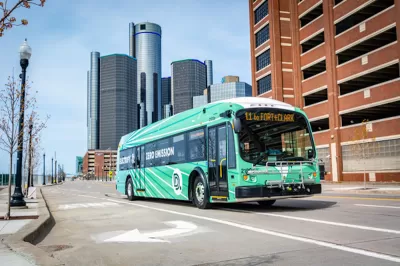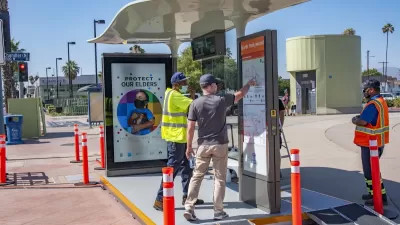The city’s thousands of bus stops are sorely lacking in seating and shelters to protect riders from rain, snow, and sun.

An analysis of city data reveals that just 5 percent of bus stops in Detroit have shelters, and only 1.5 percent have benches, reports Malachi Barrett for Bridge Detroit.
The data reveals a stunning lack of infrastructure in a city with frigid winters, which coincide with a drop in bus usage. “DDOT data shows 400,000 fewer riders in December 2024 compared to October,” Barrett notes. According to Ted Tansley, who compiled the data, “It’s a clear reflection of the lack of institutional funding.”
DDOT acknowledged that a low percentage of its bus stops have seating or shelters. However, in a statement to BridgeDetroit, the department argued focusing it’s misleading to focus on the raw percentage of stops without a shelter because 26% of bus boardings happen at a sheltered stop. In other words, the stops with higher ridership are more likely to have shelters or seating.
Transit advocates are calling on city leaders to boost funding for the Department of Transportation, which served over 250,000 bus riders each week. The department says it plans to add 250 shelters by 2027 along high-traffic routes and near areas with high concentrations of seniors.
As part of its DDOT Reimagined plan, it has set a goal to have 75 percent of riders boarding from a sheltered bus stop and improve the transit experience in other ways, but the agency needs more funding to achieve its vision. “Additional investment could add more frequency to routes, upgrade stops with shelters and benches, raise wages for employees and ultimately improve service for residents who can’t afford or to drive or don’t wish to.”
FULL STORY: Detroit bus shelters are scarce as advocates call for more funding

Alabama: Trump Terminates Settlements for Black Communities Harmed By Raw Sewage
Trump deemed the landmark civil rights agreement “illegal DEI and environmental justice policy.”

Study: Maui’s Plan to Convert Vacation Rentals to Long-Term Housing Could Cause Nearly $1 Billion Economic Loss
The plan would reduce visitor accommodation by 25% resulting in 1,900 jobs lost.

Why Should We Subsidize Public Transportation?
Many public transit agencies face financial stress due to rising costs, declining fare revenue, and declining subsidies. Transit advocates must provide a strong business case for increasing public transit funding.

Wind Energy on the Rise Despite Federal Policy Reversal
The Trump administration is revoking federal support for renewable energy, but demand for new projects continues unabated.

Passengers Flock to Caltrain After Electrification
The new electric trains are running faster and more reliably, leading to strong ridership growth on the Bay Area rail system.

Texas Churches Rally Behind ‘Yes in God’s Back Yard’ Legislation
Religious leaders want the state to reduce zoning regulations to streamline leasing church-owned land to housing developers.
Urban Design for Planners 1: Software Tools
This six-course series explores essential urban design concepts using open source software and equips planners with the tools they need to participate fully in the urban design process.
Planning for Universal Design
Learn the tools for implementing Universal Design in planning regulations.
Caltrans
Smith Gee Studio
Institute for Housing and Urban Development Studies (IHS)
City of Grandview
Harvard GSD Executive Education
Toledo-Lucas County Plan Commissions
Salt Lake City
NYU Wagner Graduate School of Public Service





























